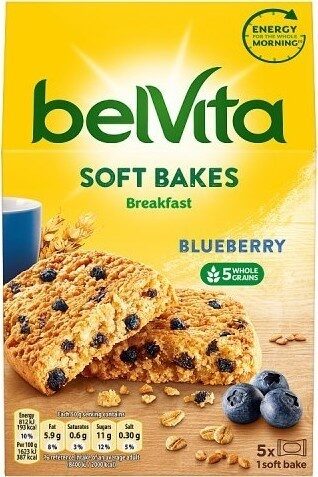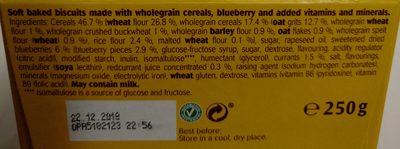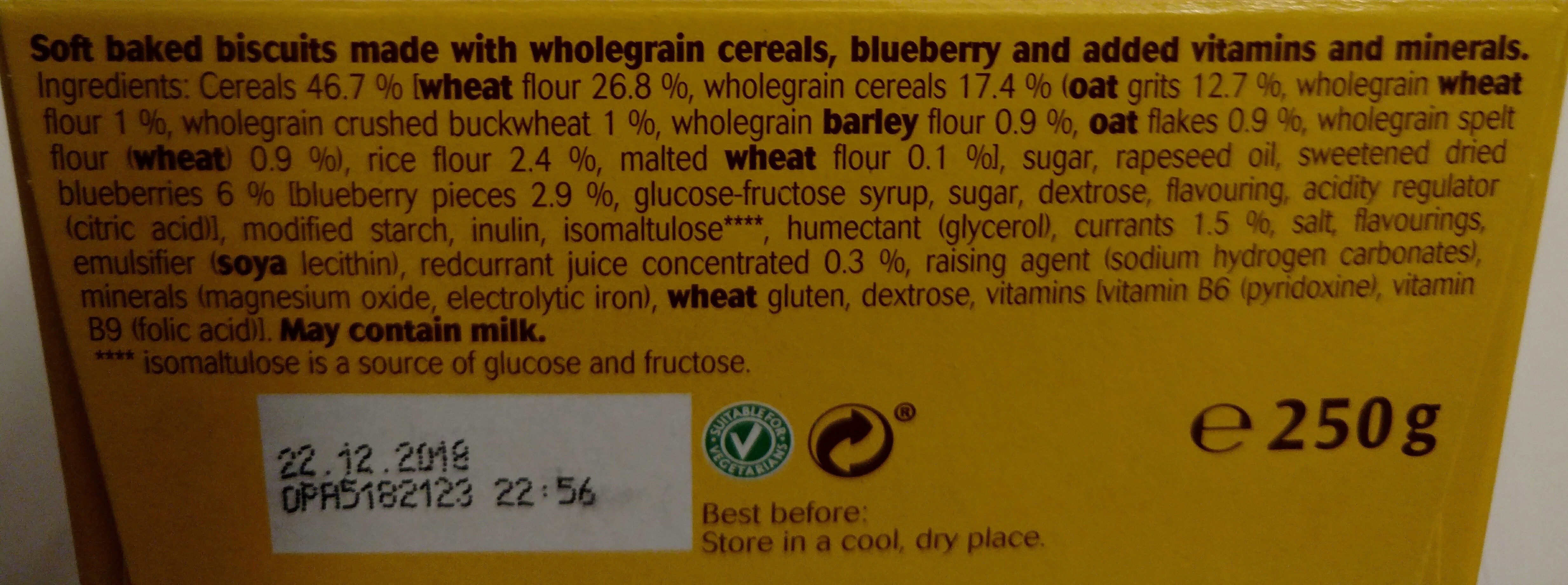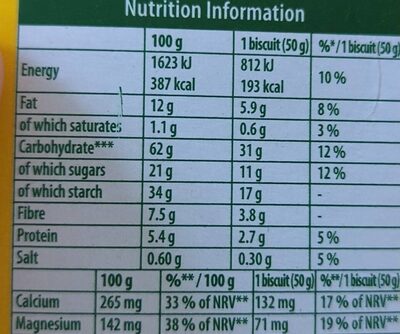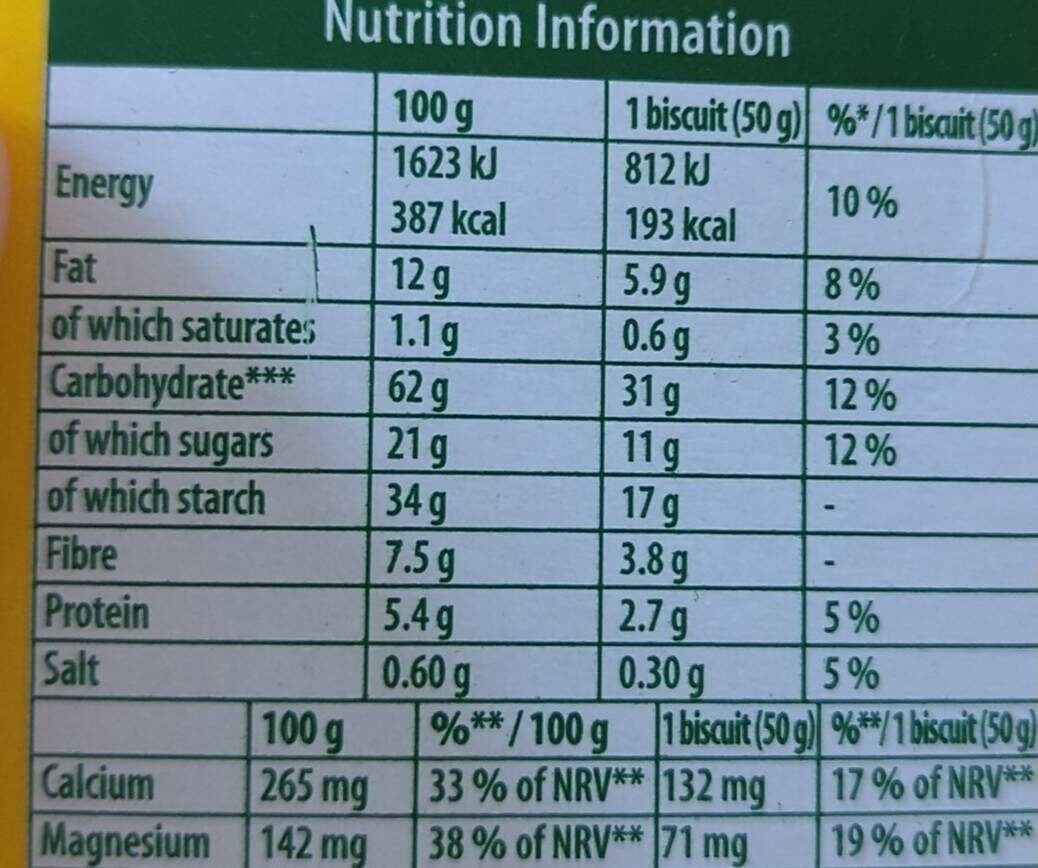Help us make food transparency the norm!
As a non-profit organization, we depend on your donations to continue informing consumers around the world about what they eat.
The food revolution starts with you!
Breakfast Biscuits Soft Bakes Filled Blueberry - Belvita
Breakfast Biscuits Soft Bakes Filled Blueberry - Belvita
This product page is not complete. You can help to complete it by editing it and adding more data from the photos we have, or by taking more photos using the app for Android or iPhone/iPad. Thank you!
×
Barra-kodea: 7622210840066 (EAN / EAN-13)
Ontziratzea: en:Card-box
Markak: Belvita
Kategoriak: en:Snacks, en:Breakfasts, en:Sweet snacks, en:Biscuits and cakes, Gaileta, en:Dry biscuits, en:Breakfast biscuit
Etiketak, ziurtagiriak, sariak: en:Isomaltulose is a source of glucose and fructose
Matching with your preferences
Health
Osagaiak
-
48 ingredients
: cereals 46,7% [wheat flour 26,8 %, wholegrain cereals 17,4 % (oat grits 12,7 %, wholegrain wheat flour 1 %, wholegrain crushed buckwheat 1 %, wholegrain barley flour 0,9 %, oat flakes 0,9 %, wholegrain spelt flour (wheat) 0,9 %), rice flour 2,4 %, malted wheat flour 0,1 %], sugar, rapeseed oil, sweetened dried blueberries 6 % [blueberry pieces 2,9 %, glucose-fructose syrup, sugar, dextrose, flavouring, acidity regulator (citric acid)], modified starch, inulin, isomaltulose****, humectant (glycerol), currants 1,5 %, salt, flavourings, emulsifier (soya lecithin), redcurrant juice concentrated 0,3 %, raising agent (sodium hydrogen carbonates), minerals (magnesium oxide, electrolytic iron), wheat gluten, dextrose, vitamins [vitamin b6 (pyridoxine), vitamin b9 (folic acid)], may contain milk, **** isomaltulose is a source of glucose and fructose, e 250g 22,12,2018 opr5182123 22:56 vege ins for sn r best before:Alergenoak: en:Gluten, en:SoybeansAztarnak: en:Milk
Food processing
-
Ultra processed foods
Elements that indicate the product is in the 4 - Ultra prozesatutako elikagaiak eta edariak group:
- Gehigarria: E14XX
- Gehigarria: E322
- Gehigarria: E422 - Glizerina
- Osagaia: Dextrose
- Osagaia: Emulsifier
- Osagaia: Flavouring
- Osagaia: Glukosa
- Osagaia: Gluten
- Osagaia: Humectant
Food products are classified into 4 groups according to their degree of processing:
- Prozesatu gabeko edo ahalik eta gutxien prozesatutako elikagaiak
- Sukaldaritzako osagaiak prozesatu
- Prozesatutako jakiak
- Ultra processed foods
The determination of the group is based on the category of the product and on the ingredients it contains.
Gehigarriak
-
E322
Lecithin: Lecithin -UK: , US: , from the Greek lekithos, "egg yolk"- is a generic term to designate any group of yellow-brownish fatty substances occurring in animal and plant tissues, which are amphiphilic – they attract both water and fatty substances -and so are both hydrophilic and lipophilic-, and are used for smoothing food textures, dissolving powders -emulsifying-, homogenizing liquid mixtures, and repelling sticking materials.Lecithins are mixtures of glycerophospholipids including phosphatidylcholine, phosphatidylethanolamine, phosphatidylinositol, phosphatidylserine, and phosphatidic acid.Lecithin was first isolated in 1845 by the French chemist and pharmacist Theodore Gobley. In 1850, he named the phosphatidylcholine lécithine. Gobley originally isolated lecithin from egg yolk—λέκιθος lekithos is "egg yolk" in Ancient Greek—and established the complete chemical formula of phosphatidylcholine in 1874; in between, he had demonstrated the presence of lecithin in a variety of biological matters, including venous blood, in human lungs, bile, human brain tissue, fish eggs, fish roe, and chicken and sheep brain. Lecithin can easily be extracted chemically using solvents such as hexane, ethanol, acetone, petroleum ether, benzene, etc., or extraction can be done mechanically. It is usually available from sources such as soybeans, eggs, milk, marine sources, rapeseed, cottonseed, and sunflower. It has low solubility in water, but is an excellent emulsifier. In aqueous solution, its phospholipids can form either liposomes, bilayer sheets, micelles, or lamellar structures, depending on hydration and temperature. This results in a type of surfactant that usually is classified as amphipathic. Lecithin is sold as a food additive and dietary supplement. In cooking, it is sometimes used as an emulsifier and to prevent sticking, for example in nonstick cooking spray.Source: Wikipedia (Ingeles)
-
E322i - Lezitina
Lecithin: Lecithin -UK: , US: , from the Greek lekithos, "egg yolk"- is a generic term to designate any group of yellow-brownish fatty substances occurring in animal and plant tissues, which are amphiphilic – they attract both water and fatty substances -and so are both hydrophilic and lipophilic-, and are used for smoothing food textures, dissolving powders -emulsifying-, homogenizing liquid mixtures, and repelling sticking materials.Lecithins are mixtures of glycerophospholipids including phosphatidylcholine, phosphatidylethanolamine, phosphatidylinositol, phosphatidylserine, and phosphatidic acid.Lecithin was first isolated in 1845 by the French chemist and pharmacist Theodore Gobley. In 1850, he named the phosphatidylcholine lécithine. Gobley originally isolated lecithin from egg yolk—λέκιθος lekithos is "egg yolk" in Ancient Greek—and established the complete chemical formula of phosphatidylcholine in 1874; in between, he had demonstrated the presence of lecithin in a variety of biological matters, including venous blood, in human lungs, bile, human brain tissue, fish eggs, fish roe, and chicken and sheep brain. Lecithin can easily be extracted chemically using solvents such as hexane, ethanol, acetone, petroleum ether, benzene, etc., or extraction can be done mechanically. It is usually available from sources such as soybeans, eggs, milk, marine sources, rapeseed, cottonseed, and sunflower. It has low solubility in water, but is an excellent emulsifier. In aqueous solution, its phospholipids can form either liposomes, bilayer sheets, micelles, or lamellar structures, depending on hydration and temperature. This results in a type of surfactant that usually is classified as amphipathic. Lecithin is sold as a food additive and dietary supplement. In cooking, it is sometimes used as an emulsifier and to prevent sticking, for example in nonstick cooking spray.Source: Wikipedia (Ingeles)
-
E330 - Azido zitriko
Citric acid: Citric acid is a weak organic acid that has the chemical formula C6H8O7. It occurs naturally in citrus fruits. In biochemistry, it is an intermediate in the citric acid cycle, which occurs in the metabolism of all aerobic organisms. More than a million tons of citric acid are manufactured every year. It is used widely as an acidifier, as a flavoring and chelating agent.A citrate is a derivative of citric acid; that is, the salts, esters, and the polyatomic anion found in solution. An example of the former, a salt is trisodium citrate; an ester is triethyl citrate. When part of a salt, the formula of the citrate ion is written as C6H5O3−7 or C3H5O-COO-3−3.Source: Wikipedia (Ingeles)
-
E422 - Glizerina
Glycerol: Glycerol -; also called glycerine or glycerin; see spelling differences- is a simple polyol compound. It is a colorless, odorless, viscous liquid that is sweet-tasting and non-toxic. The glycerol backbone is found in all lipids known as triglycerides. It is widely used in the food industry as a sweetener and humectant and in pharmaceutical formulations. Glycerol has three hydroxyl groups that are responsible for its solubility in water and its hygroscopic nature.Source: Wikipedia (Ingeles)
-
E500
Sodium carbonate: Sodium carbonate, Na2CO3, -also known as washing soda, soda ash and soda crystals, and in the monohydrate form as crystal carbonate- is the water-soluble sodium salt of carbonic acid. It most commonly occurs as a crystalline decahydrate, which readily effloresces to form a white powder, the monohydrate. Pure sodium carbonate is a white, odorless powder that is hygroscopic -absorbs moisture from the air-. It has a strongly alkaline taste, and forms a moderately basic solution in water. Sodium carbonate is well known domestically for its everyday use as a water softener. Historically it was extracted from the ashes of plants growing in sodium-rich soils, such as vegetation from the Middle East, kelp from Scotland and seaweed from Spain. Because the ashes of these sodium-rich plants were noticeably different from ashes of timber -used to create potash-, they became known as "soda ash". It is synthetically produced in large quantities from salt -sodium chloride- and limestone by a method known as the Solvay process. The manufacture of glass is one of the most important uses of sodium carbonate. Sodium carbonate acts as a flux for silica, lowering the melting point of the mixture to something achievable without special materials. This "soda glass" is mildly water-soluble, so some calcium carbonate is added to the melt mixture to make the glass produced insoluble. This type of glass is known as soda lime glass: "soda" for the sodium carbonate and "lime" for the calcium carbonate. Soda lime glass has been the most common form of glass for centuries. Sodium carbonate is also used as a relatively strong base in various settings. For example, it is used as a pH regulator to maintain stable alkaline conditions necessary for the action of the majority of photographic film developing agents. It acts as an alkali because when dissolved in water, it dissociates into the weak acid: carbonic acid and the strong alkali: sodium hydroxide. This gives sodium carbonate in solution the ability to attack metals such as aluminium with the release of hydrogen gas.It is a common additive in swimming pools used to raise the pH which can be lowered by chlorine tablets and other additives which contain acids. In cooking, it is sometimes used in place of sodium hydroxide for lyeing, especially with German pretzels and lye rolls. These dishes are treated with a solution of an alkaline substance to change the pH of the surface of the food and improve browning. In taxidermy, sodium carbonate added to boiling water will remove flesh from the bones of animal carcasses for trophy mounting or educational display. In chemistry, it is often used as an electrolyte. Electrolytes are usually salt-based, and sodium carbonate acts as a very good conductor in the process of electrolysis. In addition, unlike chloride ions, which form chlorine gas, carbonate ions are not corrosive to the anodes. It is also used as a primary standard for acid-base titrations because it is solid and air-stable, making it easy to weigh accurately.Source: Wikipedia (Ingeles)
-
E500ii - Sodio hidrogenokarbonato
Sodium carbonate: Sodium carbonate, Na2CO3, -also known as washing soda, soda ash and soda crystals, and in the monohydrate form as crystal carbonate- is the water-soluble sodium salt of carbonic acid. It most commonly occurs as a crystalline decahydrate, which readily effloresces to form a white powder, the monohydrate. Pure sodium carbonate is a white, odorless powder that is hygroscopic -absorbs moisture from the air-. It has a strongly alkaline taste, and forms a moderately basic solution in water. Sodium carbonate is well known domestically for its everyday use as a water softener. Historically it was extracted from the ashes of plants growing in sodium-rich soils, such as vegetation from the Middle East, kelp from Scotland and seaweed from Spain. Because the ashes of these sodium-rich plants were noticeably different from ashes of timber -used to create potash-, they became known as "soda ash". It is synthetically produced in large quantities from salt -sodium chloride- and limestone by a method known as the Solvay process. The manufacture of glass is one of the most important uses of sodium carbonate. Sodium carbonate acts as a flux for silica, lowering the melting point of the mixture to something achievable without special materials. This "soda glass" is mildly water-soluble, so some calcium carbonate is added to the melt mixture to make the glass produced insoluble. This type of glass is known as soda lime glass: "soda" for the sodium carbonate and "lime" for the calcium carbonate. Soda lime glass has been the most common form of glass for centuries. Sodium carbonate is also used as a relatively strong base in various settings. For example, it is used as a pH regulator to maintain stable alkaline conditions necessary for the action of the majority of photographic film developing agents. It acts as an alkali because when dissolved in water, it dissociates into the weak acid: carbonic acid and the strong alkali: sodium hydroxide. This gives sodium carbonate in solution the ability to attack metals such as aluminium with the release of hydrogen gas.It is a common additive in swimming pools used to raise the pH which can be lowered by chlorine tablets and other additives which contain acids. In cooking, it is sometimes used in place of sodium hydroxide for lyeing, especially with German pretzels and lye rolls. These dishes are treated with a solution of an alkaline substance to change the pH of the surface of the food and improve browning. In taxidermy, sodium carbonate added to boiling water will remove flesh from the bones of animal carcasses for trophy mounting or educational display. In chemistry, it is often used as an electrolyte. Electrolytes are usually salt-based, and sodium carbonate acts as a very good conductor in the process of electrolysis. In addition, unlike chloride ions, which form chlorine gas, carbonate ions are not corrosive to the anodes. It is also used as a primary standard for acid-base titrations because it is solid and air-stable, making it easy to weigh accurately.Source: Wikipedia (Ingeles)
Ingredients analysis
-
en:Palm oil free
No ingredients containing palm oil detected
Unrecognized ingredients: en:wholegrain-crushed-buckwheat, en:currants, en:electrolytic-iron, en:pyridoxine, en:e250g-22-12-2018-opr5182123-22, en:56-vege-ins-for-sn-r-best-beforeSome ingredients could not be recognized.
We need your help!
You can help us recognize more ingredients and better analyze the list of ingredients for this product and others:
- Edit this product page to correct spelling mistakes in the ingredients list, and/or to remove ingredients in other languages and sentences that are not related to the ingredients.
- Add new entries, synonyms or translations to our multilingual lists of ingredients, ingredient processing methods, and labels.
If you would like to help, join the #ingredients channel on our Slack discussion space and/or learn about ingredients analysis on our wiki. Thank you!
-
en:Vegan status unknown
Unrecognized ingredients: en:wholegrain-crushed-buckwheat, en:Isomaltulose, en:currants, en:electrolytic-iron, en:pyridoxine, Azido foliko, Azido foliko, en:e250g-22-12-2018-opr5182123-22, en:56-vege-ins-for-sn-r-best-beforeSome ingredients could not be recognized.
We need your help!
You can help us recognize more ingredients and better analyze the list of ingredients for this product and others:
- Edit this product page to correct spelling mistakes in the ingredients list, and/or to remove ingredients in other languages and sentences that are not related to the ingredients.
- Add new entries, synonyms or translations to our multilingual lists of ingredients, ingredient processing methods, and labels.
If you would like to help, join the #ingredients channel on our Slack discussion space and/or learn about ingredients analysis on our wiki. Thank you!
-
en:Vegetarian status unknown
Unrecognized ingredients: en:wholegrain-crushed-buckwheat, en:Isomaltulose, en:currants, en:electrolytic-iron, en:pyridoxine, Azido foliko, Azido foliko, en:e250g-22-12-2018-opr5182123-22, en:56-vege-ins-for-sn-r-best-beforeSome ingredients could not be recognized.
We need your help!
You can help us recognize more ingredients and better analyze the list of ingredients for this product and others:
- Edit this product page to correct spelling mistakes in the ingredients list, and/or to remove ingredients in other languages and sentences that are not related to the ingredients.
- Add new entries, synonyms or translations to our multilingual lists of ingredients, ingredient processing methods, and labels.
If you would like to help, join the #ingredients channel on our Slack discussion space and/or learn about ingredients analysis on our wiki. Thank you!
-
Details of the analysis of the ingredients
We need your help!
Some ingredients could not be recognized.
We need your help!
You can help us recognize more ingredients and better analyze the list of ingredients for this product and others:
- Edit this product page to correct spelling mistakes in the ingredients list, and/or to remove ingredients in other languages and sentences that are not related to the ingredients.
- Add new entries, synonyms or translations to our multilingual lists of ingredients, ingredient processing methods, and labels.
If you would like to help, join the #ingredients channel on our Slack discussion space and/or learn about ingredients analysis on our wiki. Thank you!
: cereals 46.7% (wheat flour, wholegrain cereals (oat 12.7%, wholegrain wheat flour 1%, wholegrain crushed buckwheat 1%, wholegrain barley flour 0.9%, oat flakes 0.9%, wholegrain spelt flour 0.9% (wheat)), rice flour, malted wheat flour), sugar, rapeseed oil, blueberries 6% (blueberry 2.9%, glucose-fructose syrup, sugar, dextrose, flavouring, acidity regulator (citric acid)), modified starch, inulin, isomaltulose, humectant (glycerol), currants 1.5%, salt, flavourings, emulsifier (soya lecithin), redcurrant juice 0.3%, raising agent (sodium hydrogen carbonates), minerals (magnesium oxide, electrolytic iron), wheat gluten, dextrose, vitamins, vitamin b6 (pyridoxine), vitamins, vitamin b9, folic acid, e250g 22‚12‚2018 opr5182123 22 (56 vege ins for sn r best before)- cereals -> en:cereal - vegan: yes - vegetarian: yes - percent: 46.7
- wheat flour -> en:wheat-flour - vegan: yes - vegetarian: yes - ciqual_proxy_food_code: 9410
- wholegrain cereals -> en:wholemeal-cereal - vegan: yes - vegetarian: yes
- oat -> en:oat - vegan: yes - vegetarian: yes - ciqual_food_code: 9310 - percent: 12.7
- wholegrain wheat flour -> en:whole-wheat-flour - vegan: yes - vegetarian: yes - ciqual_proxy_food_code: 9410 - percent: 1
- wholegrain crushed buckwheat -> en:wholegrain-crushed-buckwheat - percent: 1
- wholegrain barley flour -> en:wholemeal-barley-flour - vegan: yes - vegetarian: yes - ciqual_food_code: 9550 - percent: 0.9
- oat flakes -> en:oat-flakes - vegan: yes - vegetarian: yes - ciqual_food_code: 9311 - percent: 0.9
- wholegrain spelt flour -> en:wholemeal-spelt-flour - vegan: yes - vegetarian: yes - ciqual_food_code: 9480 - percent: 0.9
- wheat -> en:wheat - vegan: yes - vegetarian: yes - ciqual_proxy_food_code: 9410
- rice flour -> en:rice-flour - vegan: yes - vegetarian: yes - ciqual_food_code: 9520
- malted wheat flour -> en:malted-wheat-flour - vegan: yes - vegetarian: yes - ciqual_proxy_food_code: 9410
- sugar -> en:sugar - vegan: yes - vegetarian: yes - ciqual_proxy_food_code: 31016
- rapeseed oil -> en:rapeseed-oil - vegan: yes - vegetarian: yes - from_palm_oil: no
- blueberries -> en:blueberry - vegan: yes - vegetarian: yes - ciqual_food_code: 13028 - percent: 6
- blueberry -> en:blueberry - vegan: yes - vegetarian: yes - ciqual_food_code: 13028 - percent: 2.9
- glucose-fructose syrup -> en:glucose-fructose-syrup - vegan: yes - vegetarian: yes - ciqual_food_code: 31077
- sugar -> en:sugar - vegan: yes - vegetarian: yes - ciqual_proxy_food_code: 31016
- dextrose -> en:dextrose - vegan: yes - vegetarian: yes - ciqual_proxy_food_code: 31016
- flavouring -> en:flavouring - vegan: maybe - vegetarian: maybe
- acidity regulator -> en:acidity-regulator
- citric acid -> en:e330 - vegan: yes - vegetarian: yes
- modified starch -> en:modified-starch - vegan: yes - vegetarian: yes - ciqual_proxy_food_code: 9510
- inulin -> en:inulin - vegan: yes - vegetarian: yes
- isomaltulose -> en:isomaltulose
- humectant -> en:humectant
- glycerol -> en:e422 - vegan: maybe - vegetarian: maybe
- currants -> en:currants - percent: 1.5
- salt -> en:salt - vegan: yes - vegetarian: yes - ciqual_food_code: 11058
- flavourings -> en:flavouring - vegan: maybe - vegetarian: maybe
- emulsifier -> en:emulsifier
- soya lecithin -> en:soya-lecithin - vegan: yes - vegetarian: yes - ciqual_food_code: 42200
- redcurrant juice -> en:red-currant-juice - vegan: yes - vegetarian: yes - ciqual_food_code: 13019 - percent: 0.3
- raising agent -> en:raising-agent
- sodium hydrogen carbonates -> en:e500ii - vegan: yes - vegetarian: yes
- minerals -> en:minerals
- magnesium oxide -> en:e530 - vegan: yes - vegetarian: yes
- electrolytic iron -> en:electrolytic-iron
- wheat gluten -> en:wheat-gluten - vegan: yes - vegetarian: yes
- dextrose -> en:dextrose - vegan: yes - vegetarian: yes - ciqual_proxy_food_code: 31016
- vitamins -> en:vitamins - vegan: yes - vegetarian: yes
- vitamin b6 -> en:vitamin-b6 - vegan: yes - vegetarian: yes
- pyridoxine -> en:pyridoxine
- vitamins -> en:vitamins - vegan: yes - vegetarian: yes
- vitamin b9 -> en:folic-acid
- folic acid -> en:folic-acid
- e250g 22‚12‚2018 opr5182123 22 -> en:e250g-22-12-2018-opr5182123-22
- 56 vege ins for sn r best before -> en:56-vege-ins-for-sn-r-best-before
Elikadura
-
Average nutritional quality
⚠ ️Warning: the amount of fruits, vegetables and nuts is not specified on the label, it was estimated from the list of ingredients: 19This product is not considered a beverage for the calculation of the Nutri-Score.
Positive points: 5
- Proteinak: 3 / 5 (balioa: 5.4, rounded value: 5.4)
- Fiber: 5 / 5 (balioa: 7.5, rounded value: 7.5)
- Fruits, vegetables, nuts, and colza/walnut/olive oils: 0 / 5 (balioa: 19.625, rounded value: 19.6)
Negative points: 11
- Energia: 4 / 10 (balioa: 1619, rounded value: 1619)
- Azukreak: 4 / 10 (balioa: 21, rounded value: 21)
- Gantz saturatua: 1 / 10 (balioa: 1.1, rounded value: 1.1)
- Sodioa: 2 / 10 (balioa: 240, rounded value: 240)
The points for proteins are not counted because the negative points are greater or equal to 11.
Nutritional score: (11 - 5)
Nutri-Score:
-
Nutrient levels
-
Koipe in moderate quantity (12%)
What you need to know- A high consumption of fat, especially saturated fats, can raise cholesterol, which increases the risk of heart diseases.
Recommendation: Limit the consumption of fat and saturated fat- Choose products with lower fat and saturated fat content.
-
Gantz-azido ase in low quantity (1.1%)
What you need to know- A high consumption of fat, especially saturated fats, can raise cholesterol, which increases the risk of heart diseases.
Recommendation: Limit the consumption of fat and saturated fat- Choose products with lower fat and saturated fat content.
-
Azukre in high quantity (21%)
What you need to know- A high consumption of sugar can cause weight gain and tooth decay. It also augments the risk of type 2 diabetes and cardio-vascular diseases.
Recommendation: Limit the consumption of sugar and sugary drinks- Sugary drinks (such as sodas, fruit beverages, and fruit juices and nectars) should be limited as much as possible (no more than 1 glass a day).
- Choose products with lower sugar content and reduce the consumption of products with added sugars.
-
Gatz arrunt in moderate quantity (0.6%)
What you need to know- A high consumption of salt (or sodium) can cause raised blood pressure, which can increase the risk of heart disease and stroke.
- Many people who have high blood pressure do not know it, as there are often no symptoms.
- Most people consume too much salt (on average 9 to 12 grams per day), around twice the recommended maximum level of intake.
Recommendation: Limit the consumption of salt and salted food- Reduce the quantity of salt used when cooking, and don't salt again at the table.
- Limit the consumption of salty snacks and choose products with lower salt content.
-
-
Nutrition facts
Nutrition facts As sold
for 100 g / 100 mlCompared to: en:Breakfast biscuit Energia 1.619 kj
(387 kcal)-% 9 Koipe 12 g -% 4 Gantz-azido ase 1,1 g -% 55 Carbohydrates 62 g -% 8 Azukre 21 g +% 21 Fiber 7,5 g Proteina 5,4 g -% 31 Gatz arrunt 0,6 g +% 6 Fruits‚ vegetables‚ nuts and rapeseed‚ walnut and olive oils (estimate from ingredients list analysis) 19,625 %
Ingurumena
-
Eco-Score C - Moderate environmental impact
The Eco-Score is an experimental score that summarizes the environmental impacts of food products.→ The Eco-Score was initially developped for France and it is being extended to other European countries. The Eco-Score formula is subject to change as it is regularly improved to make it more precise and better suited to each country.Life cycle analysis
-
Average impact of products of the same category: B (Score: 69/100)
Kategoria: Breakfast biscuit (cookie)
Kategoria: Breakfast biscuit (cookie)
- PEF environmental score: 0.35 (the lower the score, the lower the impact)
- including impact on climate change: 2.88 kg CO2 eq/kg of product
Stage Impact Agriculture
80.5 %Processing
11.8 %Ontziratzea
3.1 %Transportation
3.2 %Distribution
1.4 %Consumption
0.0 %
Bonuses and maluses
-
Missing origins of ingredients information
Malus: -5
⚠ ️ The origins of the ingredients of this product are not indicated.
If they are indicated on the packaging, you can modify the product sheet and add them.
If you are the manufacturer of this product, you can send us the information with our free platform for producers.
-
Packaging with a medium impact
Malus: -10
Shape Material Recycling Impact Box Unknown Altua ⚠ ️ The information about the packaging of this product is not sufficiently precise (exact shapes and materials of all components of the packaging).⚠ ️ For a more precise calculation of the Eco-Score, you can modify the product page and add them.
If you are the manufacturer of this product, you can send us the information with our free platform for producers.
Eco-Score for this product
-
Impact for this product: C (Score: 54/100)
Produktua: Breakfast Biscuits Soft Bakes Filled Blueberry - Belvita
Life cycle analysis score: 69
Sum of bonuses and maluses: -15
Final score: 54/100
-
Carbon footprint
-
Equal to driving 1.5 km in a petrol car
288 g CO² per 100g of product
The carbon emission figure comes from ADEME's Agribalyse database, for the category: Breakfast biscuit (cookie) (Source: ADEME Agribalyse Database)
Stage Impact Agriculture
82.9 %Processing
7.9 %Ontziratzea
3.8 %Transportation
4.7 %Distribution
0.7 %Consumption
0.0 %
Ontziratzea
-
Packaging with a medium impact
-
Packaging parts
Box
-
Bilgarriaren materialak
Material % Bilgarriaren pisua
-
Transportation
-
Origins of ingredients
Missing origins of ingredients information
⚠ ️ The origins of the ingredients of this product are not indicated.
If they are indicated on the packaging, you can modify the product sheet and add them.
If you are the manufacturer of this product, you can send us the information with our free platform for producers.Add the origins of ingredients for this product Add the origins of ingredients for this product
Report a problem
-
Incomplete or incorrect information?
Category, labels, ingredients, allergens, nutritional information, photos etc.
If the information does not match the information on the packaging, please complete or correct it. Open Food Facts is a collaborative database, and every contribution is useful for all.
Datuen iturria
Product added on by andre-o-mob
Last edit of product page on by roboto-app.
Produktuaren orria -gatik editatua elcoco, inf, kiliweb, openfoodfacts-contributors, swipe-studio, thaialagata, yuka.ErxBBeKXEuY-QtzP3LAv_QqXK7bJIfJzIl8Nog, yuka.RzVFd0liVU9xOUlCdnRobjlRemw4ZXh1enI2WFdXS2NjKzlOSUE9PQ, yuka.sY2b0xO6T85zoF3NwEKvlmpYA4fQjCjBZi3gmEa61-qNFbHPMdtv77bbCKs.

